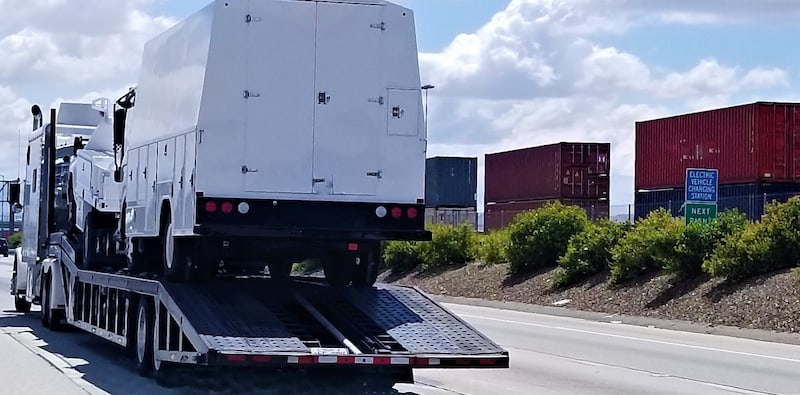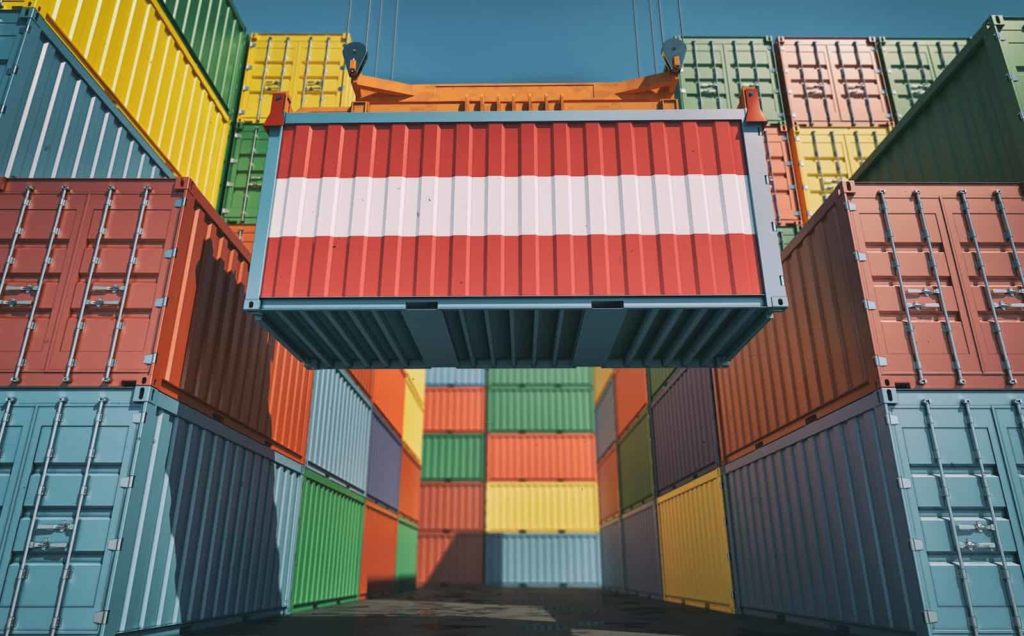This post was last updated on December 17th, 2024
In today’s globalized logistics landscape, the intermodal container is the unsung hero behind the seamless flow of goods across continents. Whether shipping by rail, truck, or sea, intermodal containers enable businesses to move cargo efficiently, safely, and affordably. In 2025, the use of intermodal containers is more important than ever as companies across Canada and worldwide look to improve supply chain resilience, reduce transportation costs, and meet rising customer expectations.
This in-depth guide to intermodal containers explores the different types of containers, their most common uses, standardized specifications, and the reasons they’ve become essential in modern freight logistics. Whether you’re a logistics manager, importer/exporter, or small business owner looking to scale your operations, understanding the role and features of the intermodal container can significantly impact your shipping efficiency and bottom line.
What Is an Intermodal Container?
An intermodal container—also known as a shipping container or ISO container—is a large, standardized, reusable steel box used to transport goods via multiple modes of transportation: rail, truck, and ocean freight. These containers are built to international specifications, enabling them to be transferred seamlessly between transport modes without unloading the cargo. This reduces handling, minimizes damage, and increases shipping speed.
In 2025, the versatility of the intermodal container has made it the backbone of intercontinental and domestic freight. It supports intermodal rail shipping, over-the-road trucking, maritime freight, and even inland barge transportation.
Why Intermodal Containers Are Essential to Supply Chain Efficiency
The widespread use of the intermodal container has transformed global and regional supply chains. Here are several reasons why:
- Seamless Mode Transfer: The ability to move goods in a single container from ship to rail to truck without repackaging minimizes handling time and risk.
- Standardized Sizes and Specs: Intermodal containers are built to consistent ISO standards, making them compatible with cranes, chassis, railcars, and port equipment worldwide.
- Reduced Costs: With less manual labor and fewer transfers, companies experience significant cost savings through improved fuel efficiency and reduced loss or damage.
- Security and Durability: Made from weather-resistant steel and equipped with secure locking systems, the intermodal container protects valuable cargo from theft, weather, and accidents.
- Scalability: Intermodal containers allow businesses of all sizes to ship goods domestically or globally without needing specialized infrastructure.
The Growth of Intermodal Container Use in 2025
As global e-commerce, just-in-time manufacturing, and sustainability pressures increase, so does the reliance on intermodal containers. In Canada, demand for intermodal rail and container shipping has surged. Businesses are turning to intermodal container solutions to streamline freight between ports like Vancouver, Prince Rupert, and Halifax and inland hubs such as Toronto, Calgary, and Montreal.
This growth is driven by:
- Labor shortages in trucking, pushing companies to integrate rail and containers.
- Environmental mandates, which promote fuel-efficient, low-emission rail freight.
- Digital logistics platforms, simplifying container tracking and booking.
- Infrastructure investment in intermodal terminals and container yards across North America.
Common Types of Intermodal Containers
Not all containers are created equal. Depending on what you’re shipping, you’ll need to select the correct intermodal container type. Here are the most widely used:
1. Standard Dry Containers
These are the most common intermodal containers used in rail, truck, and sea shipping. They are typically 20-foot or 40-foot long and are suitable for general cargo like electronics, textiles, household goods, and machinery.
2. High Cube Containers
Similar to standard containers but with an extra foot in height (usually 9.5 feet tall), high cube containers offer additional volume, making them ideal for lightweight, high-volume cargo.
3. Refrigerated Containers (Reefers)
Used for temperature-sensitive goods like food, pharmaceuticals, and chemicals, reefer containers maintain controlled environments and are critical for cold chain logistics.
4. Open Top Containers
Designed for cargo that cannot be easily loaded through standard doors—such as tall machinery or oversized equipment—these intermodal containers have a removable tarp or hard top.
5. Flat Rack Containers
Perfect for heavy or wide cargo like construction equipment, vehicles, or pipes. Flat racks have collapsible sides and can accommodate freight that doesn’t fit standard dimensions.
6. Tank Containers
Specialized cylindrical containers used to ship bulk liquids, chemicals, or food-grade products. They’re built to ISO standards and can be transported via rail, truck, or ship.
Standard Intermodal Container Dimensions and Specifications
Understanding the physical specifications of an intermodal container is essential for capacity planning and compliance with carriers’ requirements. Here are the most common sizes:
| Container Type | Length | Width | Height | Capacity (cu ft) | Max Gross Weight |
| 20′ Standard | 20 ft | 8 ft | 8.5 ft | ~1,170 cu ft | ~24,000 kg |
| 40′ Standard | 40 ft | 8 ft | 8.5 ft | ~2,390 cu ft | ~30,480 kg |
| 40′ High Cube | 40 ft | 8 ft | 9.5 ft | ~2,700 cu ft | ~30,480 kg |
| 45′ High Cube | 45 ft | 8 ft | 9.5 ft | ~3,040 cu ft | ~30,480 kg |
Most intermodal containers are constructed from corrugated steel and include forklift pockets, corner castings, and locking mechanisms to meet ISO and CSC (Container Safety Convention) standards.
What Can Be Shipped in an Intermodal Container?
The versatility of the intermodal container makes it suitable for nearly every industry. Some of the most common goods include:
- Retail and consumer goods (furniture, electronics, apparel)
- Automotive parts and finished vehicles
- Agricultural products (grain, produce, fertilizers)
- Raw materials and chemicals
- Frozen or refrigerated foods (in reefer containers)
- Heavy equipment and industrial supplies
Whether moving a single container across the country or shipping high-volume goods internationally, the intermodal container enables safe and consistent transport.

The Container Industry: Growth and Evolution
The industry has been rapidly expanding over the past few years.
What was once a laborious and slow shipping process, intermodal container shipping is now streamlined and efficient, spreading across industries including automotive, food and beverage, retail goods, manufacturers, and much more.
Invention of the intermodal freight container
The first successful intermodal shipping container is said to have been designed in 1956 by an American trucking entrepreneur named Malcom McLean.
One morning in the late 1930s, after driving his truck from Fayetteville, North Carolina, to Hoboken, New Jersey, McLean was informed that he would have to wait until the terminal crew would unstack the pallets from his truck.
Why? Because they first had to unload all of the trucks that arrived before him.
Malcom soon recognized that he was watching both time and money wasting away, and the idea of containerization was born. But, it would still take McLean nearly 20 years to start seeing the first intermodal containers in action.
The evolution of containerization
Since its modernization, intermodal transport has been a leading industry in the country and across borders.
The use of intermodal containers has revolutionized global trade and transportation by allowing cargo to be transferred seamlessly between different modes of transportation, such as trucks, trains, and ships, without repackaging the goods.
In 2012, 20.5 million intermodal containers were in existence. Today, there are said to be 600 million shipping containers in use at any given time.
What Is an Intermodal Container?
The intermodal container (or cargo container) is an intermodal freight transport system used primarily in international trade. They are built to ISO standards for seamless use across various transportation methods.
So, what is an intermodal container? They are durable, standardized containers that can hold anything from goods to liquids to heavy machinery, enabling efficient transportation through intermodal shipping.
What is intermodal containerization?
Containerization, in short, is the process of transporting goods in ISO-standard containers.
The rise of International shipping containers with the ISO standardization
The ISO standardization for intermodal cargo containers considerably improved the importation and exportation process through the seamless international shipping of goods.
Indeed, intermodal ISO containers respect specific international standardized sizes fixed by the International Organization for Standardization. This system helped the carriers optimize their fleets and transport containers for several logistics industry sectors.
Container characteristics and regulations
The most common type, dry freight containers, is commonly referred to as intermodal or shipping containers. They are usually 8 feet wide by 8.6 feet in height.
However, in recent years, high cube containers measuring 9.6 feet high have become more popular.
Containers come with a door at either end to be quickly loaded and offer weather protection and security against theft.
The average life span of an intermodal container is 25 years.

8 Different Types of Intermodal Containers
To answer the question, “what are the two types of intermodal containers?”, it’s important to note that intermodal containers can be broadly classified into standard containers and specialized containers. Below are key intermodal container types:
Dry freight container
The most common type makes up 90% of modern intermodal shipping containers.
Refrigerated containers
Intermodal cargo containers with refrigeration systems make up 6% of the world’s cargo shipments.
Open-top container
Compared to a solid roof, open-top containers have an open-top covered by a tarpaulin. This allows big and bulky items to be shipped and loaded from the top by a crane.
Flat rack container
A flat rack container is used to transport or store goods that have a specific size. The container, as the name implies, is flat, and cargo is loaded from the top or side.
Tank container
Intermodal tank containers are used to safely store and transport liquids and gases, including corrosive or flammable liquids, such as acids and gasoline.
Heated Intermodal Shipping Container
Heated containers are temperature-controlled intermodal containers designed to carry temperature-sensitive goods, offering better protection in severe weather/climate situations.
Insulated containers
Intermodal containers are insulated to protect the cargo from external elements and maintain the initial temperature.
Ventilated Containers
Ventilated intermodal containers are designed with a special ventilation system that prevents the buildup of condensation/moisture inside.
These intermodal freight containers cater to various industries with their specialized features.
Shipping Container Specifications
What is the standard size of a shipping container?
The standard intermodal container is a 20-foot long shipping container
Note that a standardized unit was born out of that standard: The Twenty-foot Equivalent Unit or TEU. It’s used as an inexact size reference for any container ship or intermodal container. One could say, “It is a 1 TEU or a 2 TEU”.
The twenty-foot containers have an internal floor area of 146 sq. ft. and 1,172 cubic ft. of volume and are either 8.6 feet to 9.6 in height.
The weight capacity for this size of intermodal container is approximately 55,126.9 lbs or 25,000 kg.
What is the biggest shipping container size?
The largest container you can find on the market is the 53-foot High Cube Container.
Those fifty-three-foot containers are made for general purposes and specifically for international trade.
Indeed, these larger-sized shipping containers have 60% more capacity than standard 40-foot containers. Especially among rail and intermodal marine container transportation, this gain represents a significant advantage when shipping merchandise abroad.
Knowing the intermodal shipping container specifications helps businesses choose the best container for their needs.
The pallet-wide containers’ sizing
You might have also heard of “pallet-wide” containers.
These are primarily European freight containers that are slightly wider than the ISO containers, built for optimal use of the internal capacity.
Indeed, the standard size of Euro-pallets is different from the ones in North America. Depending on the dimensions of the container (20-foot, 40-foot, or 45-foot), these might carry up to 7 extra Euro-pallets, representing a significant benefit for the haulers.
RailGateway’s own intermodal containers’ specifications
At RailGateway, we specialize in 53′ and 40′ high cube dry van containers with maximum weight loads of up to 59,000 lbs.
For more details, visit our container details & specifications page.
3 Types of Cargo Shipped in Intermodal Containers
Intermodal shipping containers transport a variety of cargo, including the main ones:
1. Consumer goods
Intermodal containerization is an excellent solution for companies looking to consolidate their inventory and ship it overseas or across the country quickly and easily.
2. Heavy machinery
Intermodal shipping containers are a safe and effective way to transport construction equipment, helping companies save money in the process.
3. Dry bulk cargo
Intermodal containerization is one of the safest, most cost-effective ways for dry bulk shippers to move their products around. This includes materials such as ore, coal, grain, etc.
Do you want to know what other types of cargo a container shipping enterprise could transport? Have a look at our dedicated blog post!

The basics of intermodal transportation pricing
The price of intermodal transport is generally characterized by the linehaul charges and fuel costs. Intermodal carriers determine pricing by breaking them down into these two main components.
Fuel Surcharge – This is the cost of fuel incorporated into intermodal transportation pricing and is subject to change due to fluctuations in oil prices.
Drayage – This is the cost of moving intermodal containers from short distances and includes accessorial services and costs such as receiving, unloading, loading, and other transport terminal charges.
How do I manage intermodal container costs and shipping?
Intermodal transportation rates are generally negotiated on a per-move/ per project, on-the-spot one-off, or pre-determined contracted rates. Contact us for more information about intermodal pricing or to get a quote.
If you’re looking to transport goods more efficiently and cost-effectively, intermodal shipping containers are a great solution.
These large-scale steel freight containers offer businesses the opportunity to consolidate their inventory and ship it overseas or across the country quickly and easily. They also provide protection for heavy machinery items such as construction equipment that would be difficult to move by other means of transportation.
For dry bulk shippers who need an efficient way to transport materials like sugar, grain, coal, etc., intermodal containers are one of the safest, most affordable ways available today.
Contact us to help manage intermodal costs with pricing negotiation strategies tailored specifically to your business needs.
We’ll work closely with you every step of the way, and our team will be more than happy to create a great intermodal shipping plan that drives sales by considering your needs!
The Evolution of Intermodal Shipping
Since its modernization, intermodal shipping has transformed global trade. Today, intermodal shipping containers allow goods to move efficiently between trucks, ships, and rail. This seamless system reduces cost, increases speed, and improves reliability.
Rail containers, for example, are widely used for long-distance transportation, offering a cost-effective alternative to traditional trucking.
Intermodal Container Tracking and Handling
Modern intermodal container tracking systems provide real-time visibility into cargo location and status. These technologies enhance security and streamline logistics operations.
Proper intermodal container handling ensures safe transport and reduces damage, making intermodal transport an efficient and reliable shipping method.
Intermodal Container Fleet and the Dry Van Container Market
The dry van container market is expanding rapidly due to increasing global demand. With over 600 million containers in use worldwide, the intermodal container fleet continues to grow, supporting industries like manufacturing, agriculture, and retail.
The Benefits of Intermodal Containers
- Cost-Effectiveness: Lower transportation costs, especially for bulk shipments.
- Environmental Impact: Rail-based intermodal shipping reduces carbon emissions compared to trucking.
- Efficiency: Standardized sizes make loading and unloading seamless across transport modes.
Final Thoughts: Make Intermodal Containers Your Freight Foundation
In today’s fast-moving freight environment, the ability to adapt, scale, and control costs is more important than ever. The intermodal container enables all of this and more. It simplifies shipping, supports multimodal logistics, and aligns with both economic and environmental goals.
If you’re looking to optimize your logistics, reduce transportation costs, improve cargo safety, or expand your shipping network across North America and beyond, adopting an intermodal container strategy in 2025 is not just smart—it’s essential.
Work with the Experts at RailGateway
Need help getting started with intermodal containers? Looking to shift more of your freight to rail or intermodal transport?
RailGateway is Canada’s trusted intermodal logistics provider, offering turnkey container shipping solutions tailored to your business. From container sourcing and scheduling to documentation and delivery, we handle the details so you can focus on growth.
Visit railgateway.ca today to learn how intermodal containers can power your freight strategy in 2025—and beyond.







